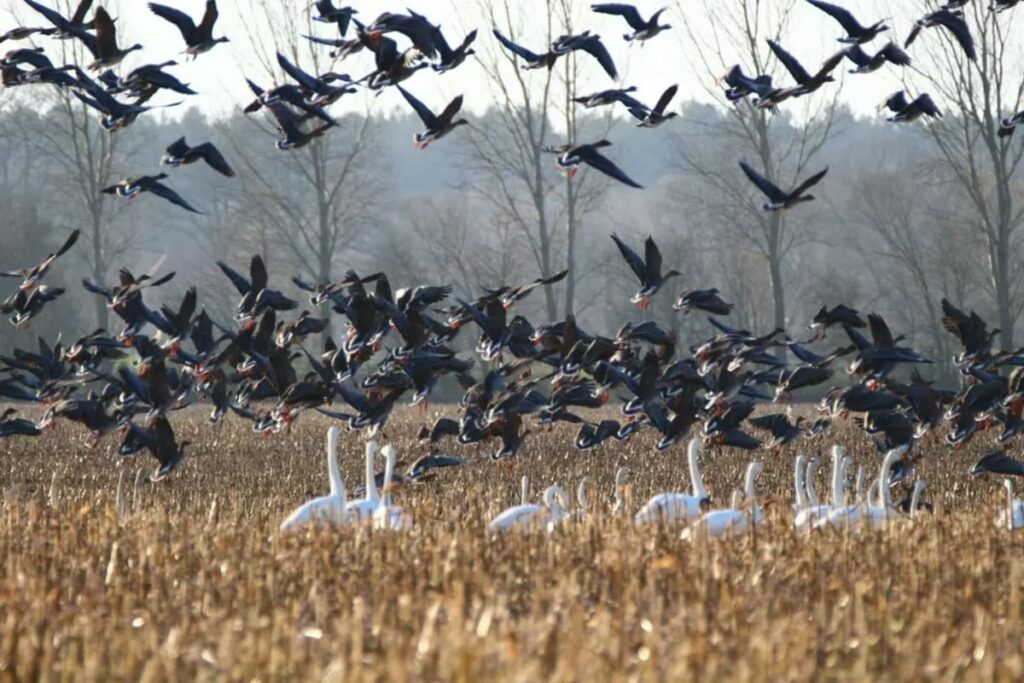If you’ve ever marveled at the long-distance flights of migratory birds, you might be aware that they’re some of nature’s most incredible athletes. Recent scientific research has unveiled even more remarkable secrets about these avian travelers—insights that not only highlight their amazing physical abilities but also raise urgent concerns about their survival in a rapidly changing world.
The Hidden Powers of Migratory Birds
Imagine the tiny dunlin, a bird no bigger than a sparrow, migrating from its breeding grounds in the Arctic to Africa, a journey that spans thousands of miles. Now picture the Arctic Tern, whose migration takes it from the polar regions to the southern oceans, racking up about 80,000 kilometers each year—more than twice the distance around the Earth. These are just a few examples of the breathtaking endurance exhibited by migratory birds, many of which are capable of crossing entire continents and oceans without missing a beat.
For years, ornithologists have studied these remarkable creatures, but the true extent of their physical capabilities remained largely unknown. Thanks to advancements in technology, researchers can now track their journeys more precisely, revealing incredible feats of endurance. Birds like the bar-tailed godwit have been found to fly non-stop for up to nine days, covering distances of over 12,000 kilometers. These birds, despite their small size, are capable of achieving remarkable speeds and distances without resting.

The Science Behind Their Extraordinary Feats
How do these birds manage such incredible feats of migration? Researchers have long believed that birds have superior navigation skills, but recent discoveries have taken this understanding a step further. Advances in biomonitoring technology, such as miniature GPS trackers and geolocators, have allowed scientists to better understand how birds adapt to such long journeys.
One of the key factors is their ability to store immense amounts of fat. For birds like the red knot, this fat serves as fuel for their long-distance flights. During migration, they can gain up to 50% of their body weight in fat, which is metabolized for energy during their flights. Moreover, many migratory species have specialized metabolic processes that allow them to burn fat more efficiently than humans, with little risk of dehydration.
Equally fascinating is the way some birds prepare for these long journeys. Certain species undergo changes to their internal organs. For example, they can shrink their digestive and reproductive organs, which helps conserve energy. Some even have the ability to reabsorb muscle tissue temporarily—an adaptation that ensures they can keep flying without the added weight.

The Role of Earth’s Magnetic Field
In addition to their remarkable endurance, migratory birds also use the Earth’s magnetic field as a natural compass. Research shows that many species have a magnetic sense embedded in their eyes. This magnetic compass helps them navigate even in the darkest of conditions, guiding them across vast oceans and across continents without fail.
For scientists, understanding how these birds navigate is like unlocking a secret code. Not only does it explain how they traverse such enormous distances, but it may also provide insights into new technologies related to human navigation and space travel.
A Growing Concern: The Impact of Climate Change
Despite their extraordinary abilities, migratory birds face significant threats due to climate change. As the Earth’s climate warms, the timing of insect hatches, for instance, is shifting, causing a mismatch between when migratory birds arrive at their breeding grounds and when their young can be fed. This shift in the food supply has led to a decline in certain species, particularly in regions where birds are missing peak food availability.
Additionally, habitat destruction due to urbanization, pollution, and changes in land use is putting immense pressure on migratory bird populations. The Swainson’s hawk, for example, was once plentiful in certain regions, but changes in their migratory habitat in South America have led to a dramatic decline in their numbers.
What We Can Do to Protect These Superheroes of the Skies ?
While these challenges are significant, there are rays of hope. Efforts to protect migratory routes and preserve crucial habitats have shown positive results. In places like the Bahamas, conservation programs have helped safeguard critical breeding grounds for birds like the Kirtland’s warbler, which has been brought back from the brink of extinction.
On a broader scale, international collaborations to protect migratory bird habitats, especially wetlands and coastal regions, have begun to make a difference. In China, efforts to preserve the Yellow Sea, a key migratory stop for many birds, have already led to positive changes in bird populations. If we can continue these efforts, there’s hope that we can help safeguard these magnificent travelers for future generations.
Conclusion: Nature’s Champions Need Our Help
The migratory bird world is filled with hidden superpowers and remarkable abilities that continue to astonish scientists. However, as climate change and habitat loss continue to threaten their survival, it’s critical that we take action now to ensure that these flying champions continue their journeys for years to come. Whether it’s protecting their migration routes or mitigating the impacts of climate change, every effort counts in preserving these incredible creatures.
By better understanding their extraordinary endurance, navigation, and adaptability, we can work together to ensure that future generations will still be able to witness these awe-inspiring travelers take to the skies.





